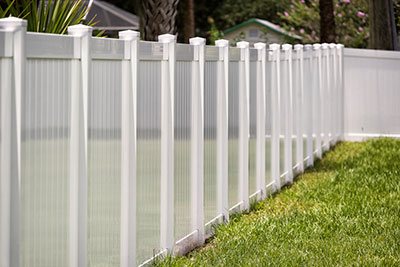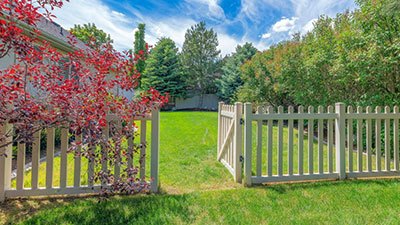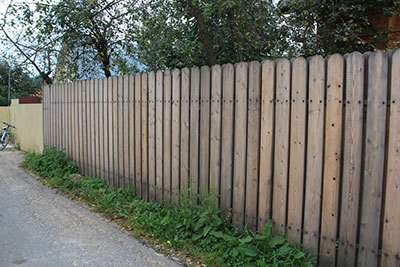As homeowners, we all want the perfect fence to provide security and beauty to our homes. Have you decided what type of fence is best for your home: vinyl or wood?
In this blog post, we’ll compare vinyl vs. wood fencing in terms of cost, durability, aesthetics, and more so that you can make an informed decision on which one is right for you!
We’ll go over the pros and cons of each material so that you have a full understanding of who’s crowned ‘king’ between vinyl vs. wood fencing. Let’s get started!
Take away key points:
- Vinyl and wooden fencing models are the two most popular options on the market
- Both fence types are easy to install and customize to meet your property needs and standards
- However, the main difference between the two fencing units is that the PVC is a more expensive model, while wooden models require more maintaining tips, and are prone to damage quickly
- You can find all benefits and disadvantages both fencing types offer, and choose the best fence standards for your household and property
Table of Contents
- Advantages and disadvantages of vinyl fences
- Benefits and drawbacks of wood fences
- PVC fencing & wood fencing: A full comparison
- Vinyl and wood fencing materials: Which is more attractive?
- Vinyl and wood fencing: Customizations & options
- Vinyl or wood fence materials: Durability
- Wood and vinyl composite fence: Price points
- Wood & vinyl: Easy to install and use
- Vinyl & wood fence options: Ease of repair
- Wood and vinyl: Maintenance requirements
- Vinyl vs. wood: Lifespan
- Wood or vinyl fencing: Which is more sustainable?
- PVC vs. wood fences: What fence offers better privacy?
- Overall comparison chart between the two fencing types
- FAQs
- Summary
If you cannot choose between vinyl fencing and wood fencing materials, you can refer to our comparison below.
We will provide you with all the crucial information to let you choose easier between vinyl fences and wooden fences.
Advantages and disadvantages of vinyl fences

Vinyl fences, made from polyvinyl chloride (PVC) plastic, offer numerous advantages to homeowners as a fence material. PVC fences are durable and require less maintenance.
Pros
– Low maintenance: PVC fencing is a top fencing choice due to its ease of upkeep. It’s resistant to pests and rot, and can be kept clean by wiping or spraying it down.
– Provides privacy: Vinyl fence panels placed close to each other create a strong barrier that blocks wind and noise from neighbors.
– Customizable: PVC fence options offer a high level of customization with a variety of colors, shapes, and textures to choose from.
Cons
– Unsustainable: Vinyl, being derived from plastic, is not an environmentally-friendly option for fencing material.
– Higher cost: Compared to other options like wood fence shopping, vinyl costs are more expensive per linear foot, with a price range of $3,000 to $7,000 for a fence.
– Susceptible to sun damage: High heat and sunlight exposure can result in the material becoming brittle over time, impacting its durability in extreme weather conditions.
Benefits and drawbacks of wood fences
Wood fencing has remained a popular choice for centuries, and it’s easy to see why. Here are some advantages and disadvantages to keep in mind when shopping for a new fence:
Pros
– Classic look: A wood fence has a timeless, traditional appearance that can add curb appeal to any property.
– Customizable: Wood can easily be cut and shaped to create unique designs to fit any style preference.
– Affordable: Wood fences are often less expensive than other various styles like vinyl or metal.
Cons
– Maintenance: Wood requires a regular maintenance schedule like staining, sealing, and painting to prevent rotting or warping. They must be pressure-treated with power-washing to keep the regular cleaning optimal.
– Vulnerable: Wood is susceptible to insect infestations and can be damaged easily by weather-related events like heavy rain, snow, or strong winds. So, it’s not as durable as other models.
– Durability: Compared to other materials, wood fences may have a shorter lifespan depending on the wood species and quality, and may require more repairs.
PVC fencing & wood fencing: A full comparison
Vinyl and wood fences have a few key differences between wood and vinyl that you’ll want to consider.
Here’s a side-by-side comparison to help you make the right choice:
Vinyl and wood fencing materials: Which is more attractive?
Both wood and vinyl fencing offers the ability to customize your fence to suit your personal style preference. With options in tones and textures, you can have a sleek, modern, rustic, and classic look with either material.
Wood fences can offer a more natural appearance, while vinyl fencing can be better suited to a modern aesthetic. Overall, both wood and vinyl fencing are equally attractive depending on personal taste for most homeowners, so it’s a tie.

Vinyl and wood fencing: Customizations & options
– Wood fences: Popular wood options for the manufacturing process include cedar, soft pine, redwood, spruce, and fir. Wood fences can also be stained or painted, and arranged in various ways to achieve different appearances and levels of privacy. Still, cedar contains natural oils, so you don’t need to pressure-wash it.
– Vinyl fences: While wood has customization options, vinyl is even more versatile to install and use. This PVC material is manufactured in a variety of shades, shapes, and textures, and can even resemble wood options wrought iron, stone, and other materials.
Regarding customization, vinyl fencing is the best option due to its wide range of manufacturing options for fence material.
Vinyl or wood fence materials: Durability
If you’re looking for a fence that can withstand harsh weather conditions cold temperatures, and different elements, a durable vinyl fence installation may be the way to go.
Unlike wood fencing, many vinyl fences are designed to resist rotting, warping, decaying, chipping, and fading without additional upkeep.
In terms of durability, vinyl fencing takes the prize due to its resistance to weather and rot without the need for maintenance.
Wood and vinyl composite fence: Price points
Regarding professional installation, wood fences can cost between $11 to $45 per linear foot for professional installation, while vinyl fences cost around $15 to $40 per linear foot.
Regarding the DIY installation, a pressure-treated wood fence is a less expensive option at $1 to $10 per linear foot, compared to vinyl which costs approximately $10 to $30 per linear foot. But while vinyl fences may have higher upfront costs and installation costs, they offer a longer lifespan.
If budget is a concern, the wood privacy fence may be the better option as it has a lower overall cost for both professional and DIY setups.
Wood & vinyl: Easy to install and use
Both wood and PVC fences can be installed by homeowners with basic DIY experience for the basic pine models. But, it’s advisable to hire a professional to ensure proper installation and even fence panel placement.
PVC fence kits are available for easy installation, but they require careful attention to detail to ensure precise alignment. Misaligned panels and privacy fence posts can be more easily noticeable on vinyl fences compared to natural wood fences.
Thus, concerning installation ease, it’s a tie between wood and vinyl fencing as both can be installed by DIYers with some experience.
Vinyl & wood fence options: Ease of repair
Both vinyl fencing and wooden fence requires repairs over time, but they are generally not difficult to fix.
Wood fences can be easily repaired by replacing a single damaged board, while a loose piece of vinyl fence can often be snapped back into place. Also, wood fences may require more frequent repairs than vinyl fences due to their vulnerability to weather damage.
So, when it comes to ease of wood vs. vinyl repair, repairing vinyl takes the lead as it requires less frequent repairs than wood fencing.
Wood and vinyl: Maintenance requirements
Vinyl is a preferred fencing option due to its low maintenance needs. Wood fences require a sealant every few years to slow weather damage. Those with stain or paint coatings require fresh coats every few years to maintain their appearance.
Vinyl, however, is extremely easy to maintain and can simply be sprayed down with a garden hose to remove dirt. Overall, in terms of how much maintenance, is required for the optimal fence, vinyl is the easiest option.
Vinyl vs. wood: Lifespan
While a well-maintained, high-quality wood fence can last up to 15 to 20 years, it is unlikely to outlast a vinyl fence. Vinyl fences can last decades with proper care and maintenance.
However, without proper upkeep, a wood fence may only last about five years. In terms of lifespan, vinyl fencing has the longest lifespan with proper care and maintenance.
Wood or vinyl fencing: Which is more sustainable?
When considering the sustainability of fence material, wood is the better choice. Unless it is treated with a pest- or rot-resistant coating, wood is biodegradable and a natural renewable resource.
On the other hand, vinyl fence manufacturing produces dioxins, an environmental pollutant. Additionally, vinyl fences can potentially leach chemicals into the environment.
For those who prioritize sustainability, wood is the more environmentally-friendly option.

PVC vs. wood fences: What fence offers better privacy?
Wooden fencing has been a popular choice for homeowners looking for privacy for years. It is known to provide excellent noise reduction and block out unwanted sights from your neighbors.
The best part about wooden fencing is that it can be customized in different styles and finishes depending on your preferences. Plus, wood fencing is typically more affordable than its PVC counterpart.
So, in terms of privacy, wooden fencing is a better option.
Overall comparison chart between the two fencing types
Here is the all-inclusive chart including all similarities and differences between the wood and vinyl fencing systems. Take a closer look for a better understanding:
| Feature | Wood Fencing | Vinyl Fencing |
| Appearance | Classic, charming, natural look | Modern, uniform, artificial appearance |
| Cost | Low to high, depending on quality and style | High upfront cost, but low maintenance long term |
| Maintenance | Regular upkeep required, susceptible to rotting or warping | Minimal upkeep required, resistant to rot and pests |
| Durability | Lifespan varies widely, prone to insect damage and weather-related | Long lifespan, resistant to most types of wear and tear |
| Environmental Impact | Natural, renewable resource | Made from non-renewable petroleum-based products |
Considering the differences between the two materials in terms of appearance, cost, maintenance, durability, and environmental impact can help you determine the best fencing choice for your needs.
FAQs
Is it cheaper to build a wood fence or a vinyl fence?
Wood is a cheaper option than the vinyl model.
Is PVC fencing cheaper than wood?
No, PVC fencing is more expensive than wood fencing.
Can that vinyl fence be recycled?
No, you cannot recycle vinyl fences. They are disposable in the trash.
Which fence is better: vinyl or wood?
Vinyl fences are better, as they last longer, are more durable, and offer more strength than wood fences.
How much is a 6-foot PVC fence?
For a 6-foot PVC fence, you need to spend between $15 and $40 per linear foot.
Summary
Ultimately, the choice between vinyl vs. wooden fence is subjective and depends on individual needs. Both fences provide privacy and security but in different ways.
Vinyl fencing offers increased durability, requires minimal maintenance, and won’t need expensive upkeep, while wooden fencing installs quicker, has a better ability to blend into its surroundings, and can be more economical for certain projects.
If you’re looking for an aesthetically pleasing fence that is also low-maintenance, then vinyl may be the better choice for you. However, if you’d rather save your money and need a bit more privacy then a wooden fence is likely the superior option.
So, what’s your choice?

